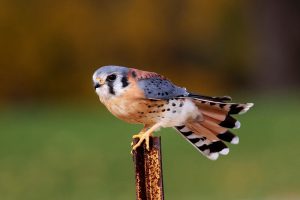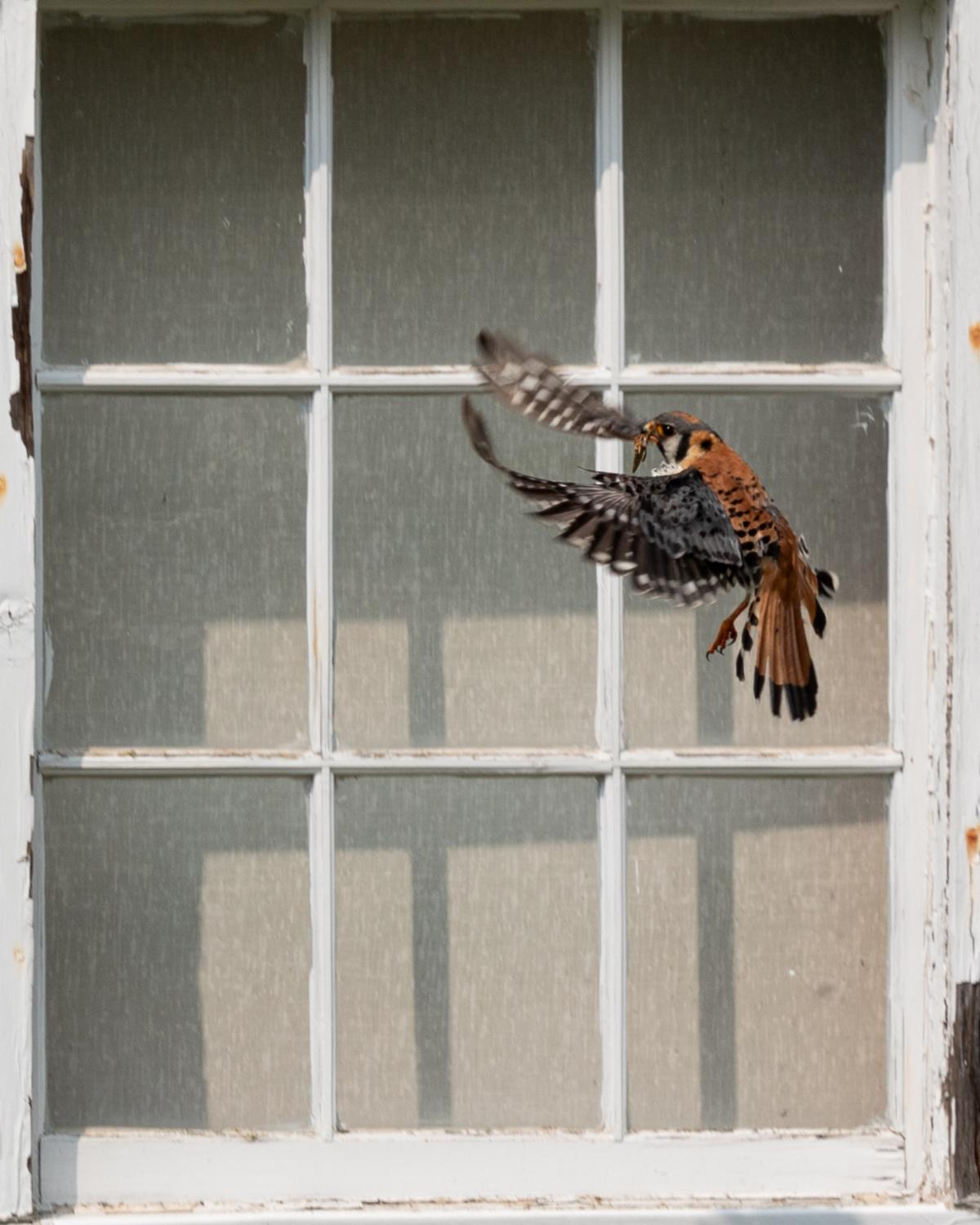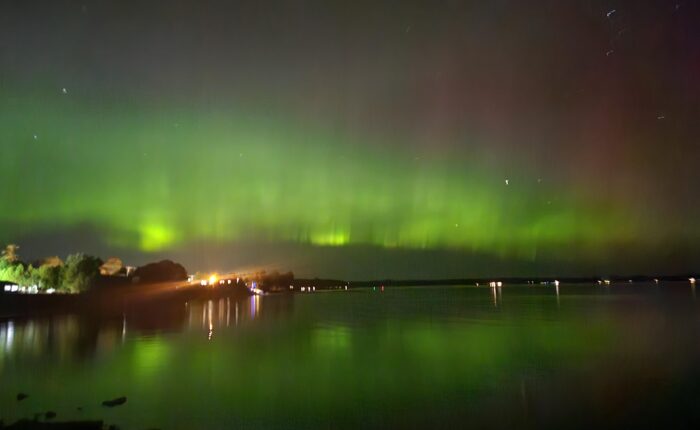
Discover where to find American kestrels in Door County’s historic barns. Learn about their nesting habits, best viewing locations, and role in Wisconsin’s agricultural heritage.
Historic Barns Provide Essential Nesting Habitat
Door County’s iconic barns and historic farm buildings serve as more than picturesque backdrops for Wisconsin tourism—they provide critical nesting habitat for one of North America’s most captivating raptors. The American kestrel has found an ideal home among Door County’s agricultural landscapes, where century-old barns offer perfect nesting opportunities in one of Wisconsin’s most scenic destinations. We have been lucky enough to have the shy birds nest in our barn at Carraig Dale Cottage for three years in a row. The top photo above is a picture taken by local photographer, Andrew Pirrung, of a parent returning to the nest with a meal for their hungry chicks.
Door County’s Perfect Kestrel Habitat
Located on Wisconsin’s thumb-shaped peninsula between Green Bay and Lake Michigan, Door County combines the agricultural heritage and natural beauty that American kestrels need to thrive. The county’s 300 square miles of farmland, orchards, and preserved open spaces create an ideal hunting ground for these small falcons, while the abundance of historic barns provides essential nesting sites.
From Sturgeon Bay to Washington Island, Door County’s landscape is dotted with traditional Wisconsin dairy barns, many dating back to the late 1800s when German and Scandinavian settlers established the area’s agricultural foundation. These weathered structures, with their natural gaps and crevices, have become invaluable real estate for American kestrels seeking nesting cavities.
The kestrel population in Door County benefits from the county’s unique geography. The peninsula’s position between two major water bodies moderates the climate and creates diverse microclimates that support abundant insect populations—the primary food source for these raptors. Door County’s commitment to preserving its agricultural heritage through historic barn preservation has inadvertently created a network of nesting sites that supports one of Wisconsin’s most important kestrel populations.
Nesting Behavior in Door County Barns
American kestrels arrive in Door County each spring, typically in late April when Wisconsin’s harsh winter begins to give way to warmer weather. These cavity-nesting birds immediately begin searching for suitable nesting sites, and Door County’s historic barns provide exactly what they need.
Unlike many raptors that build stick nests, kestrels require existing cavities for nesting. Door County’s traditional barn construction, with its heavy timber framing and board-and-batten siding, creates numerous gaps and openings that kestrels can utilize. Common nesting sites include spaces between siding boards, openings near the roofline, unused grain chutes, and gaps in the barn’s structural framework.
Local Door County farmers and residents have observed kestrels returning to the same barn locations year after year, demonstrating the birds’ strong site fidelity. This behavior is particularly evident in the rural areas around Fish Creek, Ephraim, and Bailey’s Harbor, where historic barns remain active parts of working farms or have been preserved as part of the county’s heritage tourism appeal.
The female kestrel typically lays 4-5 eggs in her chosen barn cavity, incubating them for approximately 30 days while the male hunts in nearby fields. Door County’s diverse agricultural landscape—from the cherry orchards of Peninsula State Park area to the dairy farms inland from Sturgeon Bay—provides abundant hunting opportunities within easy flight distance of barn nesting sites.
Wisconsin’s Agricultural Heritage Supports Wildlife
Door County’s agricultural history plays a crucial role in supporting the region’s kestrel population. The county’s traditional farming practices, including maintaining open pastures and diverse crop rotations, create the mosaic of habitats that kestrels require. Many Door County farms still practice sustainable agriculture methods that support insect populations, providing the grasshoppers, beetles, and other prey that kestrels need to feed their young.
The preservation of historic barns throughout Door County has been driven largely by the county’s tourism industry and heritage preservation efforts. Organizations like the Door County Historical Society and local preservation groups have worked to maintain these structures, unknowingly creating a network of nesting sites that supports Wisconsin’s kestrel population.
During the breeding season, which runs from May through August in Door County, kestrel families become integral parts of the local ecosystem. Parent birds hunt continuously in the fields surrounding their barn nesting sites, consuming thousands of insects and small rodents that could otherwise damage crops. This natural pest control service benefits Door County’s agricultural operations, from the county’s famous cherry orchards to its dairy and grain farms.
Best Places to Observe Kestrels in Door County
Visitors to Door County have excellent opportunities to observe American kestrels throughout the warmer months. The birds are commonly seen perched on barn roofs, fence posts, and power lines along Door County’s scenic rural roads. Some of the best viewing locations include:
Highway 42 Corridor: The main route through Door County passes numerous historic farms where kestrels commonly nest. Look for the birds perched on barn roofs or hunting over adjacent fields, particularly in the early morning or late afternoon.
Peninsula State Park Area: The farmland surrounding this popular Door County attraction supports several kestrel pairs. The open areas near the park’s entrance and the nearby cherry orchards provide excellent viewing opportunities.
Rural Roads Around Fish Creek and Ephraim: The backroads connecting these charming Door County towns pass through prime kestrel habitat, where historic barns and open fields create ideal conditions for these raptors.
Washington Island: The ferry ride to Door County’s northernmost community offers chances to spot kestrels hunting over the island’s agricultural areas and nesting in the island’s historic farm buildings.
Conservation Efforts in Door County
Door County’s unique position as both a major tourism destination and an active agricultural region has created opportunities for kestrel conservation. Local farmers and property owners have become increasingly aware of the importance of preserving nesting sites, with many taking steps to maintain traditional barn structures specifically for wildlife benefit.
The Door County Land Trust and other conservation organizations have worked to protect the open spaces and agricultural landscapes that kestrels require. Their efforts to preserve farmland and prevent development pressure help maintain the habitat connectivity that allows kestrel populations to thrive throughout the county.
Several Door County farms have installed artificial nest boxes to supplement natural nesting sites, recognizing the value of kestrels as natural pest controllers. These efforts have been particularly successful in areas where modern barn construction has eliminated traditional nesting cavities.
The Future of Kestrels in Door County
As Door County continues to balance development pressure with conservation needs, the relationship between kestrels and historic barns becomes increasingly important. The county’s commitment to preserving its agricultural heritage through programs like the Purchase of Development Rights has helped maintain the rural character that both tourists and kestrels value.
Climate change presents both challenges and opportunities for Door County’s kestrel population. While warmer temperatures may extend the breeding season, changes in precipitation patterns could affect insect populations that kestrels depend on. The county’s diverse agricultural landscape and commitment to sustainable farming practices provide resilience that may help kestrel populations adapt to changing conditions.
The success of American kestrels in Door County demonstrates how historic preservation and wildlife conservation can work together. As visitors continue to flock to Door County for its scenic beauty and agricultural heritage, the presence of these charismatic raptors adds another dimension to the county’s natural appeal.
Door County’s historic barns will continue to serve as essential nesting habitat for American kestrels, ensuring that future generations of both residents and visitors can enjoy the sight of these beautiful falcons hunting over Wisconsin’s most scenic agricultural landscape. The partnership between preservation efforts and wildlife conservation in Door County provides a model for how rural communities can maintain their heritage while supporting biodiversity.


